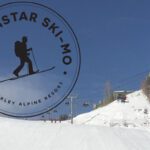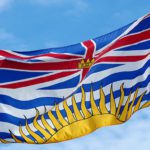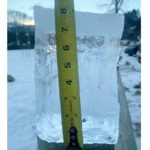Home »

History’s Historian: The Story of Naomi Miller
By Nowell Berg
You see her bicycling or walking around Wasa Lake on the Lions path, cross-country skiing around the neighbourhood during winter and recording the community’s history in a column called History Bytes.

Naomi Miller’s richly lived life includes being a wife, mother of six (five girls, one boy), a head nurse, a Girl Guide leader, Vice-president and President of the BC Historical Federation, author and historian, a true British Columbian.
Her father, Alan Pole Allsebrook, was born 1880 in Nottingham, England. At age six he went completely deaf from scarlet fever. Despite this limitation, Alan would go on to obtain a teaching certificate from the Nottingham School of Art. He then went to Paris where he learned full figure painting along with wood and stone carving. After his Paris studies, he returned to England where he worked on the construction of the Liverpool Cathedral.
In 1911, after hearing a CPR advertisement encouraging people to buy land, grow fruit and grow rich, Alan bought seven acres of water front land and a tiny cabin at Shutty Bench north of Kaslo. What wasn’t said in the CPR promotion was that it would take 30 years for an apple orchard to mature and bear fruit.
Alan and his youngest brother Eric were drafted into the First World War and returned to England in 1916. Both worked for the war effort despite physical frailties. At the end of the war (November 1918), Alan returned to Shutty Bench. Seven years later (1925) he returned to England visiting family. It was during this visit that he met Lucy Smith.
Lucy Naomi Smith, was born 1892 in Kegworth, Leicestershire. She was the local doctor’s daughter. Lucy’s good friend, Dorothy, happened to be Alan Allsebrook’s sister. Post-WW1, many English women faced a life of being single due to the death, some would say slaughter, of a whole generation of young men.
Alan and Lucy fell in love and were married in February 1925.
Lucy’s brother, Bill, was adamant there must be a telephone at Shutty Bench, which there was thanks to Andy Shutty stringing a line to Kaslo.
Born in 1927 at Kaslo, Naomi grew up at Shutty Bench, on the west side of Kootenay Lake. Each day she’d make the one-mile walk from the waterfront home and apple orchard to the one room elementary school in Shutty Bench. She was a natural student; after grade one she skipped to grade 3. “I loved school and loved my teachers,” she recalls.
In the fall of 1937, her Uncle Bill Smith, Lucy’s brother, knew that war was coming to Europe and England, so he urged Naomi’s family to make the trip back to the homeland.
On November 1, 1937, Naomi, her mother and brother Eric (born 1931) made the sea voyage across the Atlantic from Sherbrooke, Quebec, to Southampton, England.

Over the next five months, they would move 22 times while visiting all of the relatives on both sides of the family.
By Easter of 1938, Naomi was back at Shutty Bench attending school and resuming a country life by the lake.
After finishing Grade 8, Naomi was supposed to go to Kaslo for high school. However, that was not to be. The school authorities told her parents they already had their quota of students from Shutty Bench. The school offered two options: pay an extra fee for her to attend, “money we were saving for university,” or take correspondence.
Naomi took grades 9 and 10 through correspondence courses. She remembers fondly, “Mom was very, very good; she sat me down to do papers.” Only once did Naomi need to consult with teachers in Kaslo. It was for a math problem that once explained she grasped the concept and successfully completed the course.
In Grade 11, a 15-year old Naomi finally went to Kaslo High School. In this time before school buses, she would either row a boat, landing it at the current location of the SS Moyie or ride a bicycle. In the winter, travel to Kaslo High was done “nearly all by row boat.”
In 1942, the Japanese evacuation from the West Coast resulted in “about 100 ‘A’ students arriving at Kaslo High School.” Eighteen Japanese students attended Grade 11 with Naomi and five other locals. Naomi fondly recalls, “They were marvelous and I made many good friends among the Japanese students.”
After graduating high school, Naomi wanted to start the nursing program at Vancouver General Hospital (VGH). But this was put on hold because, “They wouldn’t take anyone until they were 18.
“A Japanese doctor who befriended our family told my parents to send me to UBC to get a nursing degree.” She would end up doing two years at UBC before training at VGH. After that Naomi would spend one final year at UBC to obtain a bachelor’s degree in nursing.
 Upon first arriving at UBC School of Nursing, she was not accustomed to the crowded beach at Spanish Banks. Eventually she got “acclimatized” to the big city. “I was a country kid with my own personal beach for miles,” said Naomi. But, it didn’t take long for her to fit in and succeed at nursing studies.
Upon first arriving at UBC School of Nursing, she was not accustomed to the crowded beach at Spanish Banks. Eventually she got “acclimatized” to the big city. “I was a country kid with my own personal beach for miles,” said Naomi. But, it didn’t take long for her to fit in and succeed at nursing studies.
In the spring of 1950, Naomi received her Registered Nurse (RN)designation graduating from Vancouver General. That summer she worked at the Trail Hospital before returning to UBC in the fall, “To get the last piece of the [nursing] degree.” Naomi graduated from UBC in 1951. Her class was the first to receive Bachelor of Science in Nursing (BSN) degree.
After graduation, Naomi “got an immediate job as Head Nurse at TB Willow Chest Centre.” It had 64 patients, three doctors, a number of nurses and nurse aids. “I settled in very comfortably.” She was on the TB unit for one year then transferred to a new unit for another year.
It was during her time at UBC that she first met Peter Miller.
After graduating high achool Peter, like so many his age, joined the Army. “He went overseas to England doing research for the Signal Corps.” The army then sent him back to Canada where he was sent to UBC and trained as an engineer.
Naomi Allsebrook married Peter Miller in May, 1953.
After marriage, “We started moving, moving and moving,” Naomi recalls. First it was Saskatchewan for a short time, then Edmonton for two years and next Sarnia for two years.
When news came that Peter’s parents were ailing, the young family moved west to Saskatoon where he worked at a refinery. While there, his co-workers “kept asking him questions” which Peter answered in detail. One co-worker suggested that he “explained things well and should be a teacher.”
Added to that, “In the early 1960s the average engineer faced a minimum of 13 contracts, each involving two or three moves, during his working life. Teaching looked way more stable and made return to B.C. logical,” said Naomi.
Peter made inquiries back at UBC who said he would be able to complete a teaching degree in one year. However, they also said “don’t bring the family.”

Living alone with four girls in Saskatoon didn’t sit well with her, “I went to Kaslo, worked a bit of nursing during that year.”
Peter completed a teaching degree and interviewed for jobs right away where he said he wanted to work in the West Kootenay. He was given a teaching position in Salmo (1962). They stayed four years and had two more children, a boy and girl.
It was in Salmo that Naomi got involved with Girl Guides (GG). She was an active leader with GG for 26 years. For 10 of those years she was a “trainer of other leaders.” While in Golden, Naomi was attached to the Monashee Area (Okanagan) and the Provincial HQ in Vancouver.
Over the years with GG, Naomi met hundreds of guides and leaders that “resulted in many lasting friendships.” She still belongs to GG as a “Trefoil Guild member.” She was given an honorary life membership in the Guides in 1987.
The next move for the family was to Riondel where they were expanding the school to include Grade 12.
After Riondel, the next stop was Terrace where they stayed for one year, but they could not afford to buy a home there so they made one final move to Golden. Naomi, Peter and family stayed in Golden for the next 15 years until Peter retired in 1983.
During their time in Golden, a brand new Historical Society started up. Peter was asked to be on the Board, which he did.
Naomi got involved when the Elks Club offered five lots for a Historical Society building. All the society had to do was “pay back taxes to get the land.” Bit by bit, with the help of Naomi and Peter, the Society got a museum going.
“Local history so much fun because of the personal stories,” exclaimed Naomi. “People would bring a homemade rake that Uncle John made because he couldn’t afford one. That’s were I got interested in local history.”
After Peter retired, he and Naomi move to Wasa. In January, 1983, they found a home on Maple Road and made arrangements to move. The house had not been lived in and was not finished. It became “Peter’s retirement project.”
 By this time, Naomi had become the Vice-president of the BC Historical Federation. She was President from 1986 until 1987. Then in 1988, she took over as the Editor of the Federation’s British Columbia Historical News.
By this time, Naomi had become the Vice-president of the BC Historical Federation. She was President from 1986 until 1987. Then in 1988, she took over as the Editor of the Federation’s British Columbia Historical News.
When Naomi began editing the News, it was 24 pages. After consulting with Canada Post, she realized that doubling the number of pages would cost the same postage fee, so she “upped it to 48 pages.” Naomi recalls, “In order to fill up these extra pages, I’d ask people all over the province to write stories. I made a very determined effort to cover all of B.C.”
She received “marvelous cooperation” from historical writers and local societies all over B.C.
When it came time to produce the News, it was printed by Kootenay Kwik Print. “We had to label and put 1,200 copies into mailing bags.” The packaging was all done in the front room of her Wasa home.
Naomi edited the News for 10 years as well as attended the Federation’s annual meetings. “It was terrific,” she said of that time.
During the 1990s, her activity as a member of the BC Heritage Minister’s Advisory Committee and as a Director of the BC Heritage Trust garnered her recognition and she was named an Honorary Life Member of the Kootenay Lake Historical Society in 1999.
 When the Friends of Fort Steele Society was being established, Naomi was asked to be on the Board, which she did as a founding Director. She had begun research into Ft. Steele in 1983 after arriving at Wasa. Then in 2000 she began writing a book on the town’s history that was published in 2002, Fort Steele: Gold Rush to Boom Town. Naomi spent many years as a volunteer at Fort Steele telling stories of the past to tourists.
When the Friends of Fort Steele Society was being established, Naomi was asked to be on the Board, which she did as a founding Director. She had begun research into Ft. Steele in 1983 after arriving at Wasa. Then in 2000 she began writing a book on the town’s history that was published in 2002, Fort Steele: Gold Rush to Boom Town. Naomi spent many years as a volunteer at Fort Steele telling stories of the past to tourists.
Naomi’s beloved husband Peter died November 2009.
For her work writing biographies of nurses from around B.C., in May 2010, she was named an Honorary Life Member of the BC History of Nursing Society.
From 2011 to 2013, Naomi was a Trustee on the Wasa Lake Land Improvement District (WLLID). At the age of 84, she walked over to the Kootenay River by Hanson Channel “to read water level markers.”
Over the past 14 years, Naomi has written the History Bytes column for the Tri-village Buzz, a local publication covering stories from Wasa, Ta Ta Creek and Skookumchuck. Her love of local family stories continues to shine 10 times per year; that’s 140 historical stories and counting.
In June, 2017, Naomi was recognized as the Regional District of East Kootenay Electoral Area E Volunteer of the Year for her service and commitment to the community.
Naomi Miller, 90 years of vital life lived and more to come.
e-KNOW







